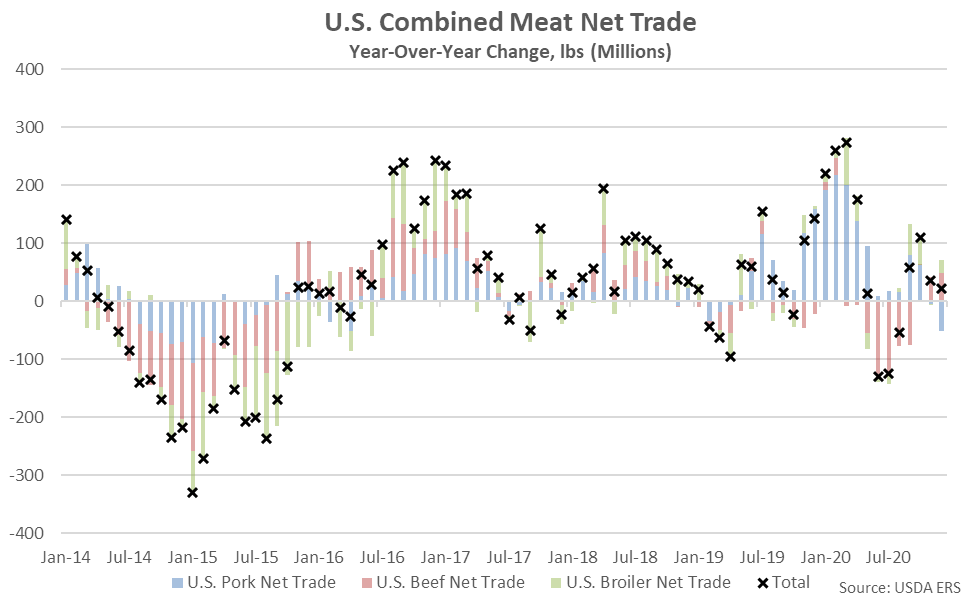U.S. Livestock & Meat Trade Update – Feb ’21
Executive Summary
U.S. livestock and meat trade figures provided by the USDA were recently updated with values spanning through Dec ’20. Highlights from the updated report include:
- U.S. net pork trade declined on a YOY basis for the second consecutive month during Dec ’20, finishing down 8.6%. Pork export volumes declined by 6.6% on a YOY basis throughout the month, finishing below previous year levels for the first time in the past 19 months on reduced Chinese demand.
- U.S. beef & veal export volumes increased 12.1% on a YOY basis throughout Dec ’20, remaining at a record high seasonal level. Net beef & veal trade finished at a positive level for the third consecutive month.
- U.S. net broiler trade finished 4.3% higher on a YOY basis throughout Dec ’20, reaching a ten year high seasonal level. The YOY increase in net broiler trade was the fourth experienced throughout the past five months.
Additional Report Details
Pork – Exports Finish Lower on a YOY Basis for the First Time in 19 Months, Net Trade Remains Lower
According to the USDA, U.S. pork export volumes finished lower on a YOY basis for the first time in the past 19 months during Dec ’20, declining by 6.6% but remaining at the second highest seasonal level on record. YOY declines in pork export volumes were led by volumes destined to China, Hong Kong & Taiwan, while pork export volumes destined to Mexico increased most significantly on a YOY basis throughout the month. A 49.7% YOY decline in pork export volumes destined to China, Hong Kong & Taiwan more than offset a 9.4% YOY increase in export volumes destined to all other countries. Pork export volumes destined to China, Hong Kong & Taiwan declined to a 16 month low level.
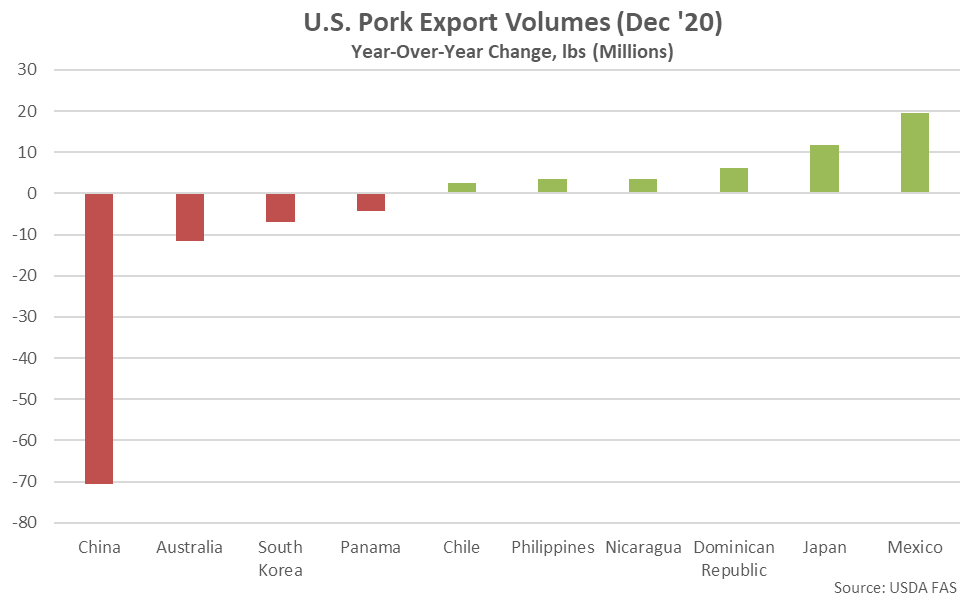
Mexico and Japan have historically been the largest importers of U.S. pork products, accounting for nearly half of the total U.S. pork export volumes throughout the past five years. Combined U.S. pork export volumes destined to Mexico and Japan have increased by 1.8% on a YOY basis throughout the past 12 months. Throughout the past 12 months, YOY increases in U.S. pork exports have been led by product destined to China, Hong Kong & Taiwan, while shipments destined to South Korea have declined most significantly on a YOY basis over the period.
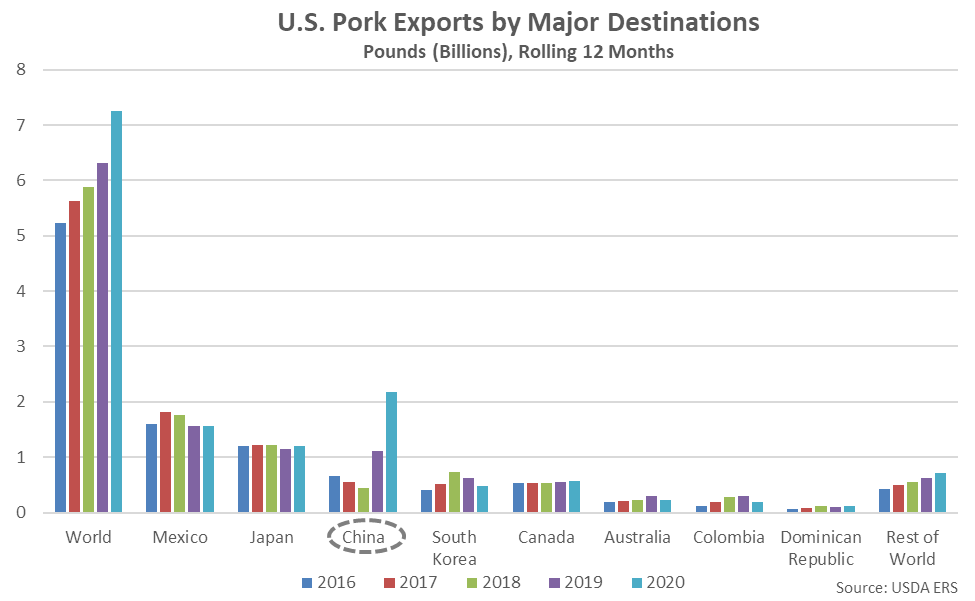
U.S. pork import volumes increased on a YOY basis for the third consecutive month during Dec ’20, finishing up 11.0%. The increase in pork import volumes, coupled with the decline in export volumes, resulted in U.S. net pork trade finishing down 8.6% YOY during Dec ’20. The YOY decline in net pork trade was the second experienced in a row and the largest experienced throughout the past four and a half years on a percentage basis. Net pork trade had finished higher on a YOY basis over 18 consecutive months through Oct ’20, prior to declining over the final two months of the 2020 calendar year. Despite declining on a YOY basis, Dec ’20 net pork trade remained at the second highest seasonal level on record.
’19-’20 annual net pork trade increased 25.4% YOY, finishing at a record high level for the third consecutive year. ’20-’21 YTD net pork trade increased by an additional 0.5% on a YOY basis throughout the first quarter of the production season, despite the recently experienced declines.
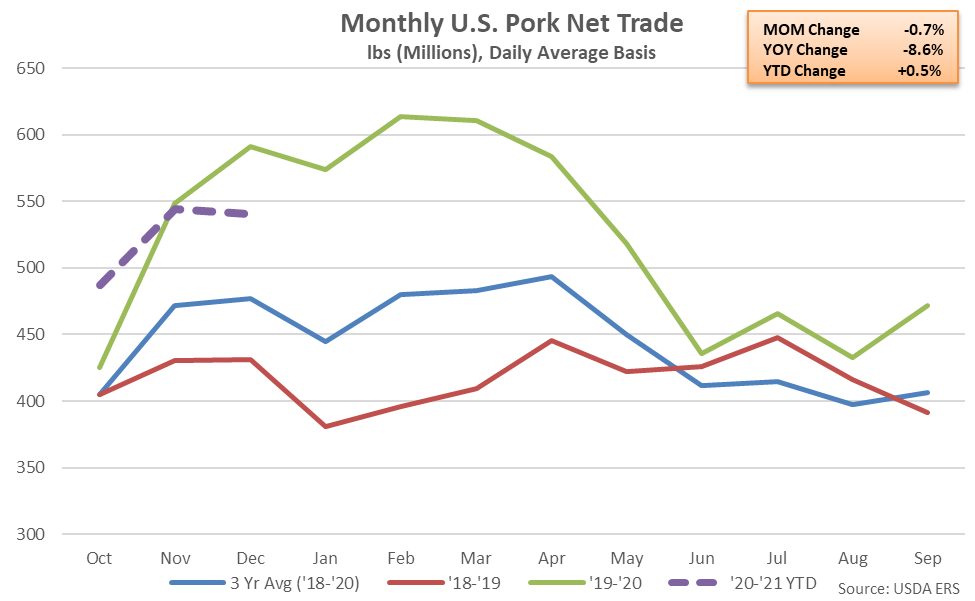
Beef & Veal – Exports Remain at a Record High Seasonal Level, Net Trade Finishes Positive
U.S. beef & veal export volumes finished higher on a YOY basis for third consecutive month during Dec ’20, increasing by 12.1% and reaching a record high seasonal level. YOY increases in U.S. beef & veal export volumes were led by shipments destined to Mexico, followed closely by shipments destined to China, Hong Kong & Taiwan. U.S. beef & veal export volumes destined to South Korea declined most significantly on a YOY basis throughout the month.
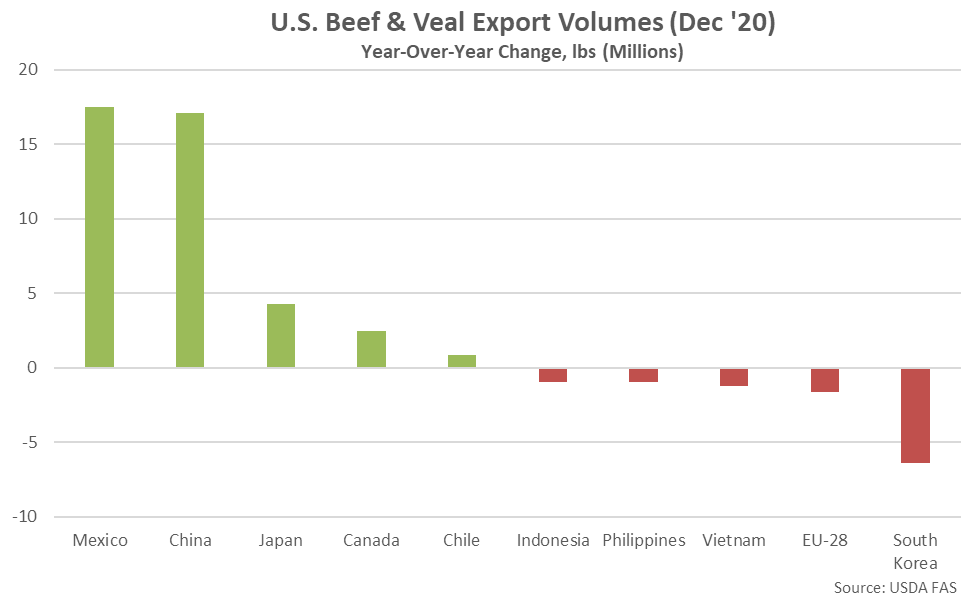
Japan, South Korea, China, Hong Kong & Taiwan, Mexico and Canada have historically been the largest importers of U.S. beef & veal products, combining to account for nearly 90% of the total U.S. beef & veal export volumes throughout the past five years. Throughout the past 12 months, U.S. beef & veal export volumes destined to Mexico have declined most significantly on a YOY basis, while shipments destined to China, Hong Kong & Taiwan have increased most significantly on a YOY basis over the period.
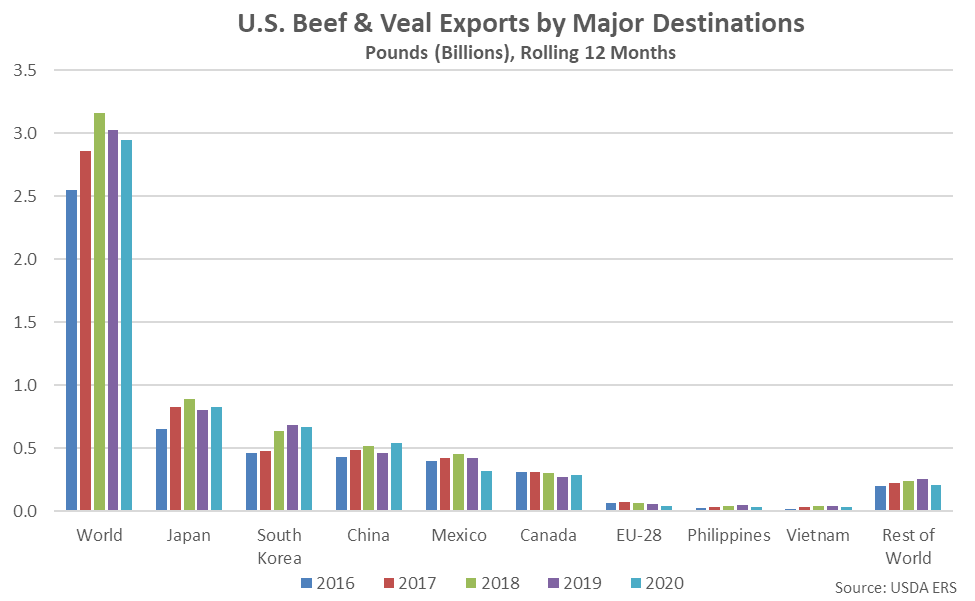
Dec ’20 U.S. beef & veal import volumes declined on a YOY basis for the second consecutive month, finishing down 8.3%. Beef & veal import volumes had finished higher on a YOY basis over five consecutive months through Oct ’20, prior to declining over the final two months of the 2020 calendar year. Beef & veal export volumes exceeded import volumes for the third consecutive month during Dec ’20, resulting in U.S. beef & veal net trade remaining at a positive level.
’19-’20 annual beef & veal net trade finished at a negative level for the first time in the past three years. ’20-’21 YTD net beef & veal trade has rebounded by 251.9% on a YOY basis throughout the first quarter of the production season, however.
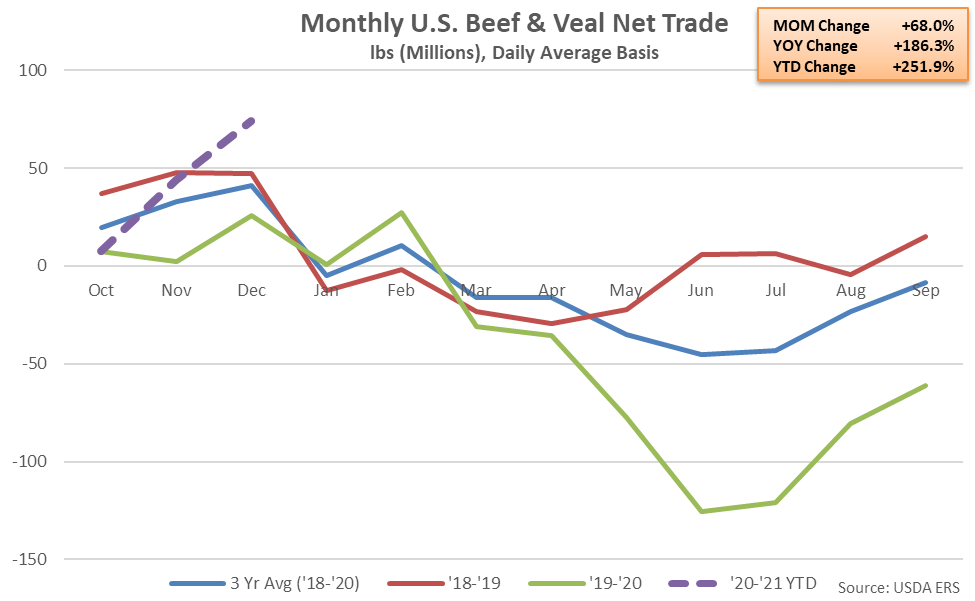
Broilers – Net Trade Reaches a Ten Year High Seasonal Level, Finishes 4.3% Higher YOY
U.S. broiler export volumes finished higher on a YOY basis for the fourth time in the past five months, increasing by 4.3% and reaching a ten year high seasonal level. YOY increases in U.S. broiler export volumes were led by shipments destined to China, Hong Kong & Taiwan, while export volumes destined to Vietnam declined most significantly on a YOY basis throughout the month.
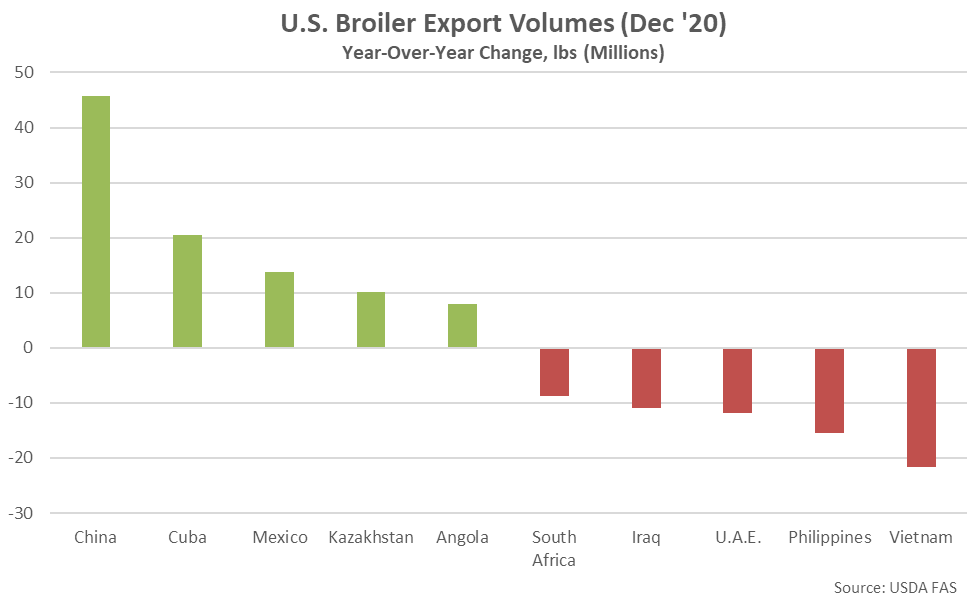
Mexico has historically been the largest importer of U.S. broilers, accounting for over one fifth of the total U.S. broiler export volumes throughout the past five years. Throughout the past 12 months, U.S. broiler export volumes destined to China, Hong Kong & Taiwan have increased most significantly on a YOY basis, while shipments destined to Angola and Cuba have declined most significantly on a YOY basis over the period.
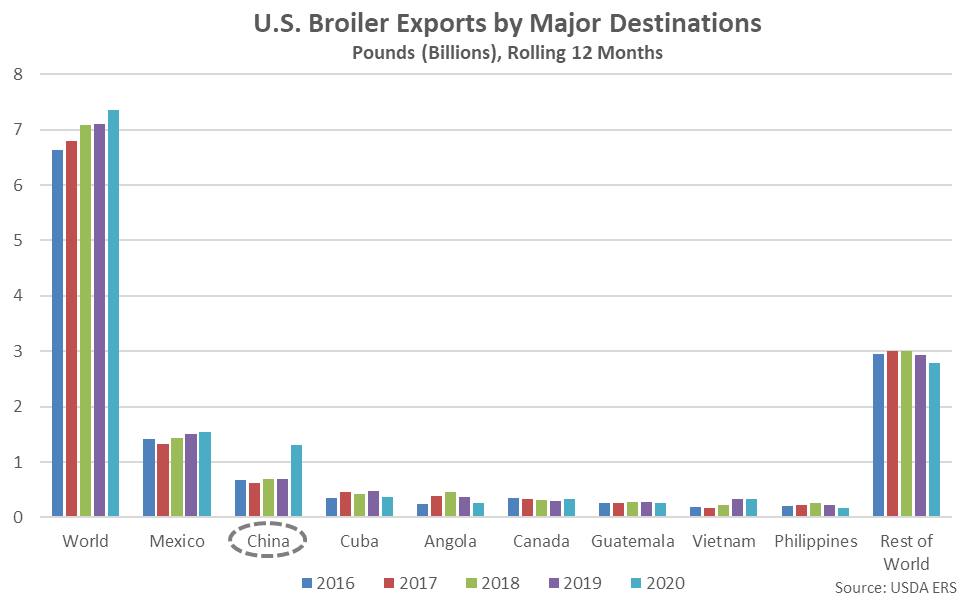
U.S. broiler import volumes finished lower on a YOY basis for the first time in the past three months during Dec ’20, declining by 6.1%. Broiler import volumes remained at insignificant levels relative to export volumes, as Dec ’20 imports amounted to just 1.9% of export volumes. The YOY increase in broiler export volumes, coupled with the YOY decline in import volumes, resulted in U.S. broiler net trade finishing 4.3% higher on a YOY basis during Dec ’20 and reaching a ten year high seasonal level. The YOY increase in broiler net trade was the fourth experienced throughout the past five months.
’19-’20 annual net broiler trade finished up 2.7% YOY, reaching a six year high level. ’20-’21 YTD net broiler trade increased by an additional 3.8% on a YOY basis throughout the first quarter of the production season and is on pace to reach a record high level.
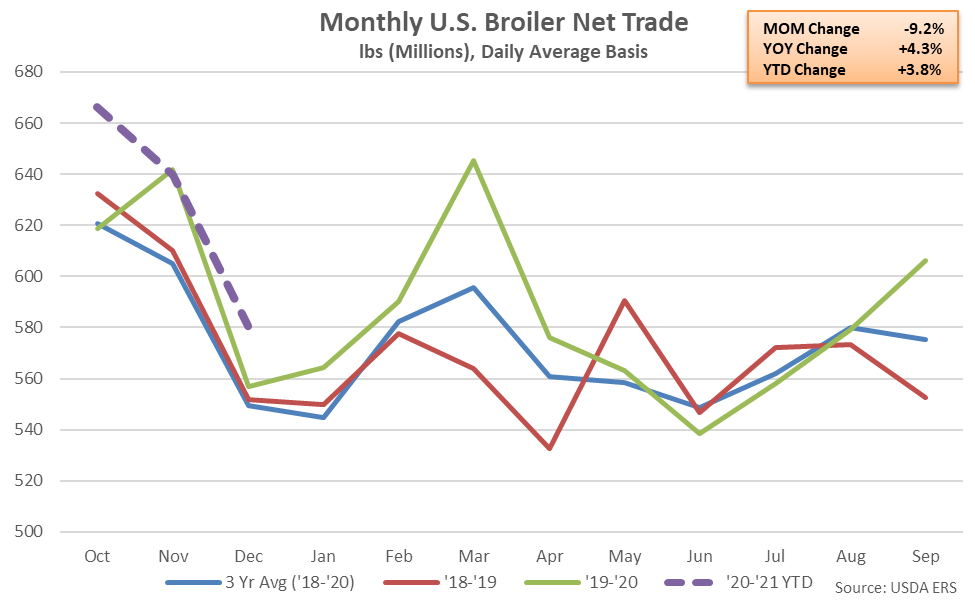
Combined Net Trade
Overall, combined net trade of U.S. pork, beef and broilers increased on a YOY basis for the fourth consecutive month during Dec ’20, finishing up 21.3 million pounds, or 1.8%. The YOY increase in combined net trade of U.S. pork, beef and broilers was the smallest experienced throughout the four month period, however. Combined net trade of U.S. pork, beef and broilers had reached an eight and a half year high growth rate throughout the month of March, prior to decelerating throughout the past three quarters of the 2020 calendar year.
